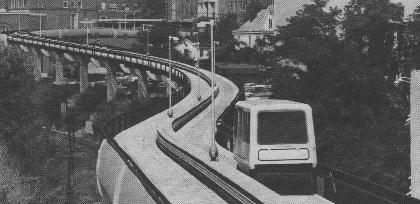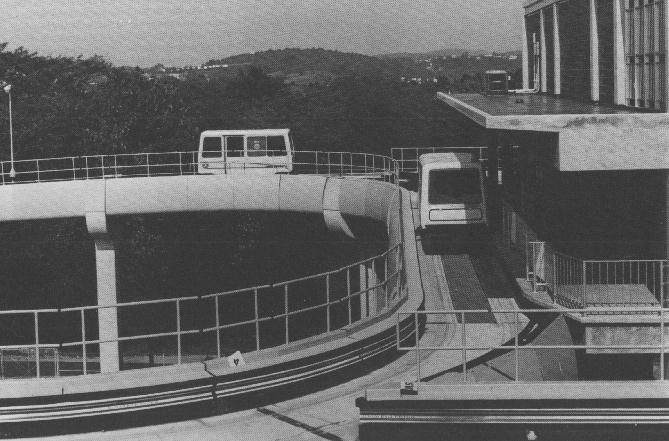

See the 12-page 2004 paper entitled Morgantown People Mover - Updated Description for additional details
A Master Plan for updating and expanding the system is now being prepared and is expected to be completed in late 2009. According to press reports, WVU has requested a budget of $34 million to implement the plan
The Morgantown GRT system has been described as the "best kept transit system secret" in the U.S. It connects various spatially separated parts of the campus of West Virginia University, located in Morgantown. The terrain in Morgantown is quite hilly and walking and bicycling are difficult as is auto travel. This is especially true during the winter. A shuttle bus system was used for many years to help students get around but it was unable to provide very good service because of heavy auto congestion and narrow, hilly roads.
Construction of the system was begun in 1971 (during the Nixon Administration) and it was finished one year later. Extensive testing then took place and it was opened for passenger service in 1975. Phase I consisted of approximately 5.2 miles of guideway, 45 vehicles, 3 stations and a maintenance/control facility. In 1978, the system was shut down so that Phase II could be constructed. The vehicle fleet was expanded to 71, 3.5 lane miles of guideway, 2.5 stations (one existing station was expanded) and a second maintenance facility were added. Operations were resumed in 1979 and have been continuous since then with a 99% reliability factor.
The system now connects the main downtown campus with the Morgantown central business district and the two suburban campuses along a linear alignment. The total system includes 8.7 miles of guideway and 5 stations. The distance between the two end stations is about 3.6 miles (6 km). Direct station-to-station service with no intermediate stops is provided. All stations are off-line. The system can be operated in either a scheduled or demand-responsive mode, depending on the predictability of demand. A photo of one of the system's stations is shown below.

Some selected operating characteristics are as follows: Headway = 15 seconds; Design capacity = 3,600 pphpl: Vehicle capacity = 8 seated, 13 standing; Vehicle Weight (empty) = 8,760 pounds; Top Speed = 30 mph, Guideway is 65% elevated, 35% at grade; Maximum Grade is 10%, Winterization = heated guideway and power rail; Power rail = 575 V ac, 3 phase; Phase I cost = $62 million (40% was R and D); Phase II cost = $64 million; Operating employees = 64; Fares = 50 cents/ride or $63 for unlimited rides during a semester; Average operating cost per passenger (1994-95) = $1.27; Total Annual Operating cost = $2.75 million; Total Revenue (1994-95) = $1.44 million; Average Daily Ridership (1995) = 14,000; Record Daily Ridership = 30,175; Ridership is 95% University students. The general public also uses the system at 50 cents per ride. As of 2003, the approximately 55%-60% of operating costs are covered by fares.
Eighty percent of the capital costs of the system were paid for with federal funds. A recent (2002) software upgrade was done by Boeing and was also funded with an 80% federal share.
The operators of this system call it the Morgantown PRT. Others do not think it is a "true" PRT since the vehicles and guideway are so large and not all of the rides are non-stop from the origin to the destination. For these reasons, we prefer to call it a Group Rapid Transit (GRT) system. Certainly, it is as close to a "true" PRT as has been achieved in the U.S. to date.
Most of the above information and much more detail about this system can be found in an article by William J. Sproule and Edward Neumann entitled "The Morgantown PRT: It Is Still Running at West Virginia University", Journal of Advanced Transportation, 25:3, 269-280 (Winter, 1991).
Some additional history is provided by a Morgantown PRT Wiki and in an article by J. Edward Anderson on the Evolution of PRT (see pages 19-20).
Six photos of the Morgantown GRT (system overview map and several stations), are available. A set of excellent, more recent color photos is also available.
More details about this system can be obtained from Robert Hendershot, Systems Engineering Manager, Morgantown Personal Rapid Transit, 99 8th Street, Morgantown, West Virginia, 26506. Phone: (304) 293-5011. E-mail address: rhenders@wvu.edu